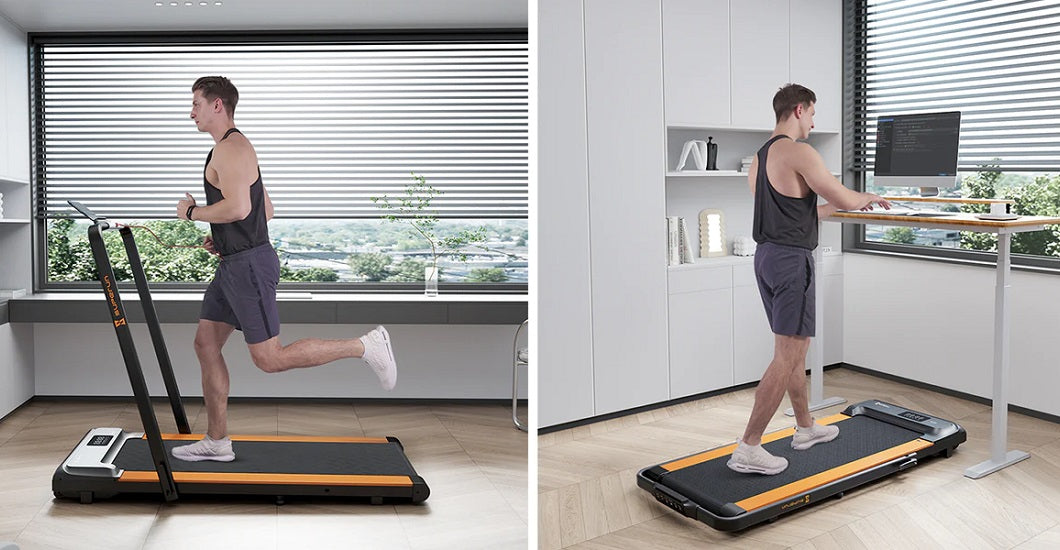In the quest for a healthier lifestyle, selecting the appropriate exercise equipment is a pivotal decision that can significantly impact your fitness. The right choice not only enhances the effectiveness of your workouts but also ensures your safety and overall satisfaction.
One of the most common dilemmas faced by fitness enthusiasts is the choice between two popular exercise machines: the stepper and the treadmill. Each of these machines offers distinct advantages and caters to specific fitness goals. The stepper, with its low-impact design, appeals to those looking to tone muscles and maintain joint health. On the other hand, the treadmill, a staple in most gyms, is renowned for its cardiovascular benefits and calorie-burning potential.
This article aims to guide you through the Stepper vs. Treadmill conundrum, providing you with valuable insights and information to aid in your decision-making process. By the time you reach the end, you'll have a clearer understanding of which exercise equipment aligns best with your fitness objectives, lifestyle, and personal preferences. Whether you're striving for weight loss, muscle toning, cardiovascular fitness, or simply seeking the perfect addition to your home gym, our goal is to empower you to take that crucial step toward a healthier and more active life.
Steppers
What is the stepper?
Stepper machines are fitness devices designed to simulate the motion of climbing stairs. They consist of two footplates that move up and down alternately, allowing users to mimic the action of climbing while keeping both feet on the machine. Steppers can be found in various forms, including the traditional step climber, mini steppers, and even some elliptical trainers with stepper-like motions.
Benefits Of Steppers
- Low-impact workout:
Steppers offer a low-impact exercise option, which means they are gentle on the joints. This makes them an excellent choice for individuals with joint issues or those recovering from injuries.
- Targeted muscle engagement:
Stepper machines primarily engage the muscles of the lower body, including the quadriceps, hamstrings, calves, and glutes. This targeted muscle engagement can help tone and strengthen these areas effectively.
- Compact and space-efficient:
Steppers are generally compact and take up less space than larger exercise equipment like treadmills. They are well-suited for home gyms or smaller workout spaces.
Drawbacks Of Steppers
- Limited variety of workouts:
Steppers primarily offer a repetitive motion that mimics stair climbing. While this can be effective for lower-body workouts, it may become monotonous for some users who prefer a more diverse range of exercises.
- Less calorie burn compared to treadmills:
Steppers, due to their low-impact nature and limited upper body engagement, typically burn fewer calories per session compared to treadmills. This might be a drawback for those aiming for high-intensity cardio workouts.
Who should consider using a stepper?
- Individuals seeking a low-impact workout to protect their joints.
- Those focusing on lower-body muscle toning and strengthening.
- People with limited workout space at home or in their fitness area.
- Those looking for an additional option to diversify their fitness routine, especially if they already have access to other equipment.
Ultimately, steppers are a valuable addition to a fitness regimen, especially for those with specific goals or physical limitations.

Treadmills
What is the treadmill?
Treadmill machines are popular fitness equipment designed for indoor or outdoor use. They consist of a motorized belt that moves continuously, allowing users to walk, jog, or run in place. Treadmills come in various models, including manual treadmills, motorized treadmills, and smart treadmills.
Benefits Of Treadmills
- Cardiovascular benefits:
Treadmills are renowned for their ability to provide effective cardiovascular workouts. They elevate the heart rate, improve endurance, and promote overall cardiovascular health. Regular treadmill use can help lower the risk of heart disease and improve lung capacity.
- Versatility in workout options:
Treadmills offer a wide range of workout options. Users can vary their speed, and incline, and even use pre-programmed workouts to target specific fitness goals. This versatility makes them suitable for users of different fitness levels and objectives.
- Weight loss potential:
Treadmills are excellent for burning calories, making them a popular choice for weight loss. The ability to adjust speed and incline allows users to create high-intensity workouts that can lead to significant calorie expenditure.
- Smart:
Smart treadmills can link to fitness apps, like PitPat where people can have training lessons and competitions online.

- Foldable:
SupeRun has folding treadmills that are good for space saving.

Drawbacks Of Treadmills
Treadmills are popular exercise machines with numerous benefits, but they also come with certain drawbacks that individuals should be aware of before incorporating them into their fitness routine. Here are some of the drawbacks of treadmills:
- Monotony:
Treadmills offer a limited range of motion compared to outdoor activities, and the repetitive nature of treadmill workouts can become monotonous over time. This boredom factor may discourage some individuals from adhering to a consistent exercise routine.
- Limited Muscle Engagement:
While treadmills are excellent for cardiovascular workouts, they primarily focus on the lower body. They do not engage the upper body as effectively as some other exercise equipment, which may limit overall muscle development.
- Lack of Natural Terrain:
Treadmills do not replicate the varied terrain and outdoor conditions that outdoor activities offer, such as wind resistance, changes in elevation, and different surfaces. This can result in a less dynamic workout experience.
Who should consider using a treadmill?
- Individuals looking to improve cardiovascular fitness and endurance.
- Those aiming for weight loss and calorie burning through high-intensity workouts.
- People who enjoy walking, jogging, or running but prefer the convenience of an indoor workout.
Treadmills are a versatile and effective piece of fitness equipment, making them a popular choice for a wide range of users.
Stepper VS. Treadmill
Steppers:
- Mimic stair-climbing motion.
- Low-impact workout, gentle on joints.
- Primarily target lower-body muscles.
- Compact and space-efficient.
- Suited for muscle toning and strengthening.
- Limited variety of workouts.
- Less calorie burn compared to treadmills.
- Ideal for users with joint issues or small workout spaces.
Treadmills:
- Continuous walking/running on a moving belt.
- Offer a wide range of workout options and versatility.
- Effective for cardiovascular fitness and weight loss.
- Larger and require more space.
- Suitable for users with adequate space and those seeking high-intensity cardio workouts.
- May become monotonous over time.
- Provide the convenience of indoor running/walking.
Conclusion
In conclusion, the choice between a stepper and a treadmill ultimately hinges on your individual fitness goals, preferences, and physical condition.
If you prioritize a low-impact, joint-friendly workout, and seek to target specific lower-body muscles, a stepper may be the better choice for you. Its compact design and space efficiency also make it ideal for those with limited workout spaces.
On the other hand, if your main objectives revolve around cardiovascular fitness, weight loss, or the convenience of indoor running, a treadmill shines. Its versatility in workout options and potential for high-calorie burn can help you achieve these goals effectively.






Leave a comment
All comments are moderated before being published.
This site is protected by hCaptcha and the hCaptcha Privacy Policy and Terms of Service apply.